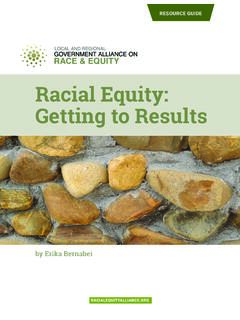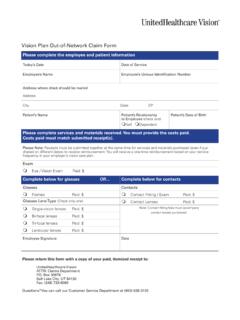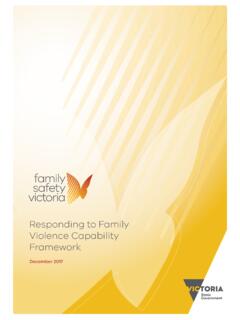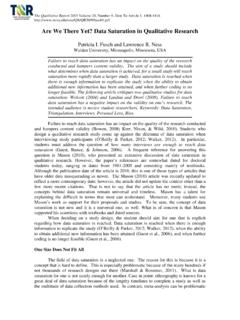Transcription of Racial Equity Toolkit
1 Racial Equity ToolkitAn Opportunity to Operationalize Nelson, Director, Government Alliance on Race and Equity Lisa Brooks, University of Washington School of Social WorkCOPYEDITINGE bonye Gussine Wilkins, Haas InstituteLAYOUT/PRODUCTIONE bonye Gussine Wilkins and Rachelle Galloway-Popotas, Haas Institute for a Fair and Inclusive SocietyCONTACT INFOJ ulie Nelson 206-816-5104 This Toolkit is published by the Government Alliance on Race and Equity , a national network of government working to achieve Racial Equity and advance opportunities for all. GARE IS A JOINT PROJECT DEC 2016 Government Alliance on Race and EquityTOOLKITR acial Equity Toolkit : An Opportunity to Operationalize Equity3 The Government Alliance on Race and Equity (GARE) is a national network of government working to achieve Racial Equity and advance opportunities for all.
2 Across the country, governmental jurisdictions are: making a commitment to achieving Racial Equity ; focusing on the power and influence of their own institutions; and, working in partnership with this occurs, significant leverage and expansion opportunities emerge, setting the stage for the achievement of Racial Equity in our provides a multi-layered approach for maximum impact by: supporting jurisdictions that are at the forefront of work to achieve Racial Equity . A few jurisdictions have already done substantive work and are poised to be a model for others. Supporting and providing best practices, tools and resources is helping to build and sustain current efforts and build a national movement for Racial Equity ; developing a pathway for entry into Racial Equity work for new jurisdictions from across the country.
3 Many jurisdictions lack the leadership and/or infrastructure to address issues of Racial inequity. Using the learnings and resources from jurisdictions at the forefront will create pathways for the increased engagement of more jurisdictions; and, supporting and building local and regional collaborations that are broadly inclusive and focused on achieving Racial Equity . To eliminate Racial inequities in our communities, devel-oping a collective impact approach firmly grounded in inclusion and Equity is necessary. Government can play a key role in collaborations for achieving Racial Equity , centering community, and leveraging institutional partnerships.
4 To find out more about GARE, visit THE GOVERNMENT ALLIANCE ON RACE & EQUITYG overnment Alliance on Race and EquityTOOLKITR acial Equity Toolkit : An Opportunity to Operationalize Equity4I. What is a Racial Equity Tool? Racial Equity tools are designed to integrate explicit consideration of Racial Equity in decisions, including policies, practices, programs, and budgets. It is both a product and a process. Use of a Racial Equity tool can help to develop strategies and actions that reduce Racial inequities and improve success for all groups. Too often, policies and programs are developed and implemented without thoughtful con-sideration of Racial Equity .
5 When Racial Equity is not explicitly brought into operations and decision-making, Racial inequities are likely to be perpetuated. Racial Equity tools provide a structure for institutionalizing the consideration of Racial Racial Equity tool: proactively seeks to eliminate Racial inequities and advance Equity ; identifies clear goals, objectives and measurable outcomes; engages community in decision-making processes; identifies who will benefit or be burdened by a given decision, examines potential unin-tended consequences of a decision, and develops strategies to advance Racial Equity and mitigate unintended negative consequences.
6 And, develops mechanisms for successful implementation and evaluation of of a Racial Equity tool is an important step to operationalizing Equity . However, it is not sufficient by itself. We must have a much broader vision of the transformation of government in order to advance Racial Equity . To transform government, we must normalize conversations about race, operationalize new behaviors and policies, and organize to achieve Racial Equity . For more information on the work of government to advance Racial Equity , check out GARE s Advancing Racial Equity and Transforming Government: A Resource Guide for Putting Ideas into Action on our website.
7 The Resource Guide provides a comprehensive and holistic ap-proach to advancing Racial Equity within government. In addition, an overview of key Racial Equity definitions is contained in Appendix Why should government use this Racial Equity Tool? From the inception of our country, government at the local, regional, state, and federal level has played a role in creating and maintaining Racial inequity. A wide range of laws and policies were passed, including everything from who could vote, who could be a citizen, who could own property, who was property, where one could live, whose land was whose and more. With the Civil Rights movement, laws and policies were passed that helped to create positive changes, including making acts of discrimination illegal.
8 However, despite progress in addressing explicit discrimination, Racial inequities continue to be deep, pervasive, and persistent across the country. Racial inequities exist across all indicators for success, including in education, criminal justice, jobs, housing, public infrastructure, and health, regardless of current inequities are sustained by historical legacies and structures and systems that repeat patterns of exclusion. Institutions and structures have continued to create and per-petuate inequities, despite the lack of explicit intention. Without intentional intervention, institutions and structures will continue to perpetuate Racial inequities.
9 Government has the ability to implement policy change at multiple levels and across multiple sectors to drive larger systemic change. Routine use of a Racial Equity tool explicitly integrates Racial Equity into gov-ernmental operations. Local and regional governmental jurisdictions that are a part of the GARE are using a Racial eq-uity tool. Some, such as the city of Seattle in Washington, Multnomah County in Oregon, and Government Alliance on Race and EquityTOOLKITR acial Equity Toolkit : An Opportunity to Operationalize Equity5the city of Madison in Wisconsin have been doing so for many years: The Seattle Race and Social Justice Initiative (RSJI) is a citywide effort to end institution-alized racism and race-based disparities in City government.
10 The Initiative was launched in 2004. RSJI includes training to all City employees, annual work plans, and change teams in every city department. RSJI first started using its Racial Equity Tool during the budget process in 2007. The following year, in recognition of the fact that the budget process was just the tip of the ice berg, use of the tool was expanded to be used in policy and pro-gram decisions. In 2009, Seattle City Council included the use of the Racial Equity Tool in budget, program and policy decisions, including review of existing programs and policies, in a resolution (Resolution 31164) affirming the City s Race and Social Justice Initiative.








